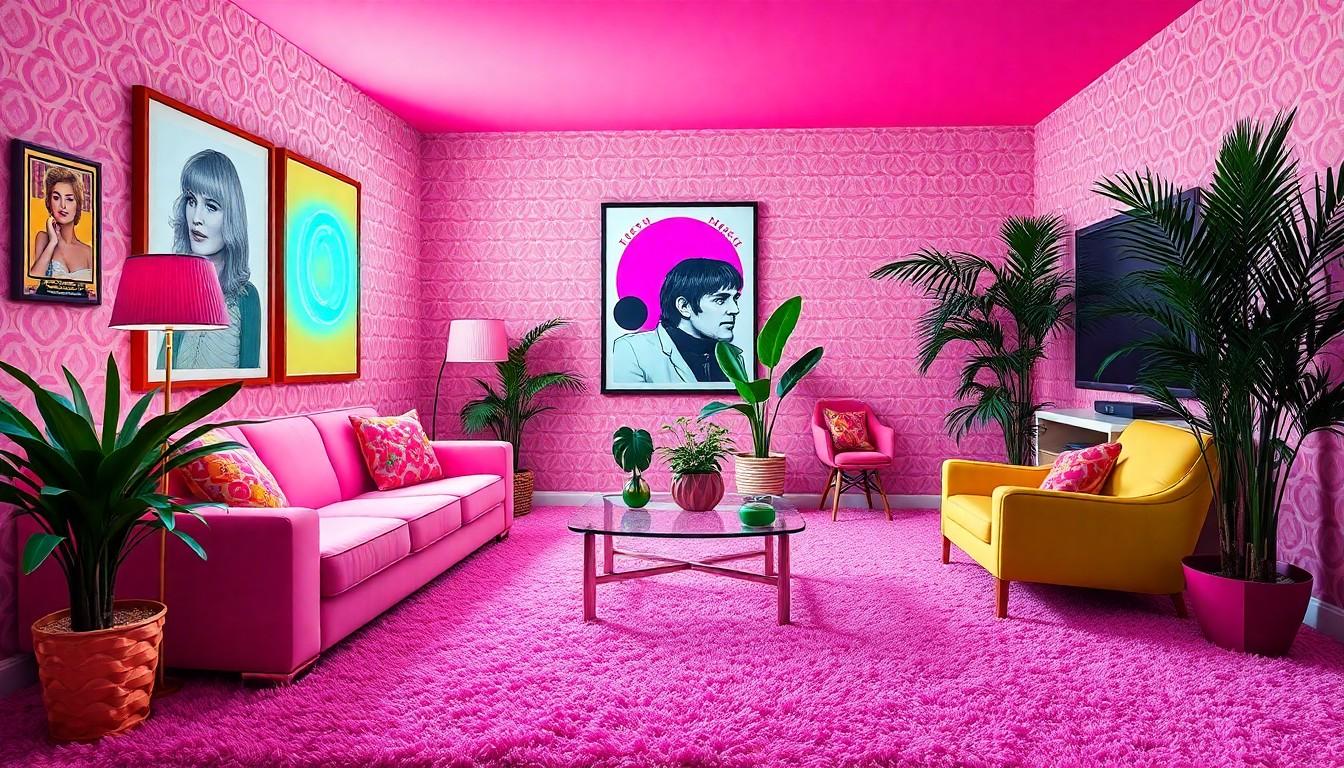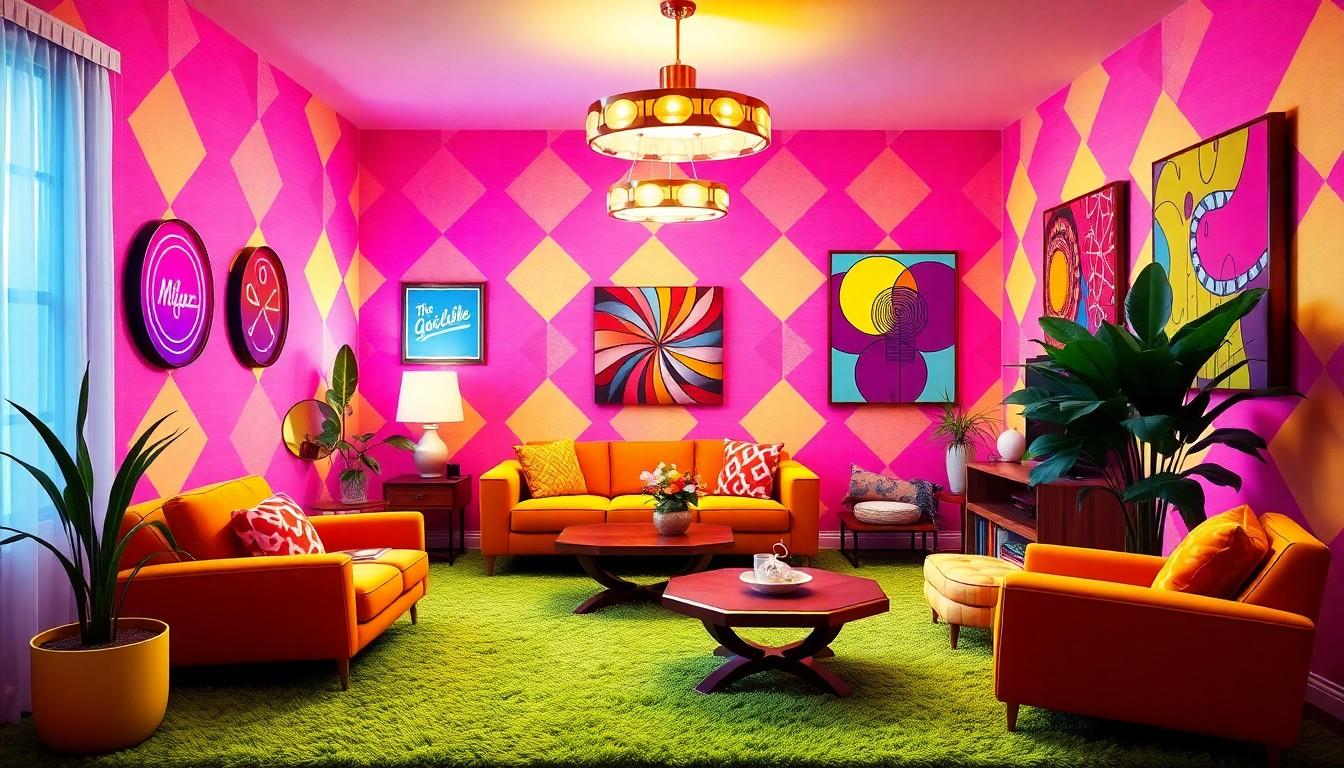Step into a time machine and prepare for a wild ride back to the 1980s, where interior design was as bold as the fashion choices. Picture vibrant colors, geometric patterns, and enough shag carpeting to make a poodle jealous. This era didn’t just break the mold; it threw it out the window while blasting synth-pop.
Overview of 1980’s Interior Design
The 1980s marked a shift in interior design trends with distinctive elements. Vibrant colors dominated spaces, featuring bright pinks, yellows, and greens. Geometric patterns graced walls, textiles, and flooring, adding a dynamic visual element. Shag carpeting became a staple, providing a sense of comfort and a touch of playfulness in homes.
Designers embraced eclectic styles, blending various influences into cohesive looks. The fusion of modern and traditional elements created unique, individualized spaces. Popular materials included glass, chrome, and plywood, offering a mixture of sophistication and casual comfort. Furniture often had angular shapes and bold lines, reflecting the decade’s design ethos.
Art pieces and decor flourished, showcasing unconventional items like neon signs and oversized prints. Plants, especially in large pots, served as natural focal points, enhancing the vibrant atmosphere. Lighting featured statement pieces, such as large chandeliers and unique floor lamps, illuminating rooms with flair.
Color blocking became a simple yet effective technique, where bold colors contrasted against neutrals. Accessories played a crucial role, with metallic touches and abstract sculptures accentuating spaces. The combination of these elements created a lively and energetic feel throughout homes during the decade.
The influence of pop culture, from music to film, directly impacted design choices. Iconic shows and movies introduced designs, which homeowners eagerly incorporated into their spaces. This connection between entertainment and interior design solidified the 1980s as a decade of creative expression and vibrant aesthetics.
Key Characteristics of 1980’s Interior Design

The 1980s boasted unique features that defined its interior design style, emphasizing vibrant aesthetics and eclectic choices.
Bold Colors and Patterns
Bright pinks, vibrant yellows, and bold greens dominated interior spaces. Solid hues complemented geometric patterns, which adorned walls and textiles. Designers often mixed these patterns, creating an engaging visual impact. Rooms frequently showcased contrasting color blocks, enhancing depth and dimension. Accessories like oversized prints and neon signs reinforced bold designs, making them focal points in every space. This era’s color palette and patterns reflected the creative energy and confidence of the decade.
Use of Textures
Textures played a significant role, adding depth to the overall design. Shag carpeting became popular, bringing comfort into living areas. Furniture choices included plush materials alongside sleek surfaces like glass and chrome, which created a striking contrast. Walls often featured textured finishes or wallpaper, enhancing the visual interest. Natural elements, such as large potted plants, introduced organic textures, balancing modern materials with nature. Statement lighting fixtures further contributed to the tactile experience and overall ambiance of 1980s interiors.
Popular Styles of the 1980’s
The 1980s embraced unique and diverse interior design styles that still resonate today. Two of the most significant trends stemmed from distinct movements: Memphis Design and Neo-Eclectic Style.
Memphis Design Movement
Memphis Design emerged in the early 1980s, characterized by its playful geometry and bold color palette. Designers favored asymmetrical shapes, bright hues, and unconventional patterns, creating a sense of whimsy. Furniture pieces often featured laminate finishes and plastic materials, offering a modern yet accessible appeal. Notably, the movement rejected traditional design norms, focusing on artistic expression rather than functionality. Iconic pieces like the Superlamp and the Carlton bookcase exemplified the movement’s commitment to vivid colors and unexpected forms. This approach captured the spirit of the 1980s, merging art and design into everyday living spaces.
Neo-Eclectic Style
Neo-Eclectic Style gained popularity toward the end of the decade, blending elements from various design traditions. Homeowners enjoyed mixing contemporary pieces with vintage finds, contributing to personalized environments. Neutral palettes dominated, allowing colorful accessories to stand out effectively. Furniture favored comfort with oversized sofas and plush seating, creating inviting spaces for relaxation. Designers incorporated a variety of textures, from sleek leather to soft fabrics, enhancing the overall tactile experience. Accessories like framed artwork and eclectic decorative items added character, reflecting individual tastes. This style represented a departure from rigid design rules, celebrating creativity and self-expression in home design.
Iconic Furniture and Accessories
The 1980s featured distinct furniture and accessories that defined the era’s interior design. Bold shapes and vibrant colors characterized these elements, reflecting the decade’s spirited energy.
The Role of Iconic Brands
Famous brands played a crucial role in shaping 1980s interior decor. Designers like Memphis Group brought playful, geometric designs into homes, introducing pieces such as the Superlamp and the Carlton bookcase. These iconic items showcased vibrant colors and unconventional forms, appealing to homeowners seeking creativity. Alongside them, brands like Knoll and Herman Miller offered sleek furniture that combined comfort and modernism. Their designs balanced aesthetics with functionality, capturing the essence of the decade’s eclectic tastes. Many consumers cherished these brands for their bold statements, establishing trends that resonate even today.
Must-Have Accessories
Essential accessories elevated 1980s interiors, creating memorable spaces. Neon signs emerged as playful decor elements, adding a pop of color and energy to living areas. Oversized prints adorned walls, illustrating vibrant art styles that embodied the decade’s flair. Large potted plants became popular focal points, grounding spaces with a natural touch. Statement lighting, including chandeliers and unique floor lamps, played a vital role in ambiance. Textiles featured graphic patterns and bold hues, from throw pillows to area rugs, providing comfort and visual interest. Together, these accessories transformed ordinary rooms into lively and personalized environments that defined the era.
Conclusion
The vibrant and bold essence of 1980s interior design continues to resonate today. Its unique blend of colors patterns and textures created spaces that were not just functional but also expressive. This era’s fearless approach to design encourages modern homeowners to embrace creativity and individuality in their own spaces.
From the playful Memphis Design Movement to the eclectic Neo-Eclectic Style the 1980s paved the way for a more personalized approach to interior decor. The lasting impact of this decade serves as a reminder of the power of design to reflect cultural shifts and personal style. As trends evolve the spirit of the 1980s remains a source of inspiration for those looking to infuse their homes with character and charm.

